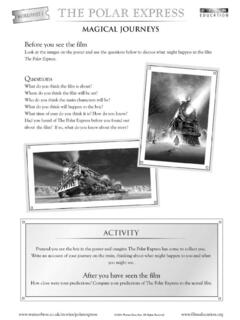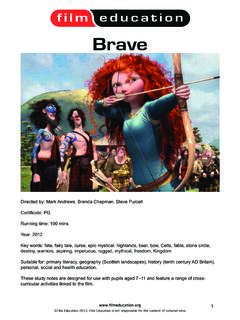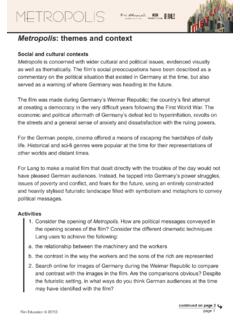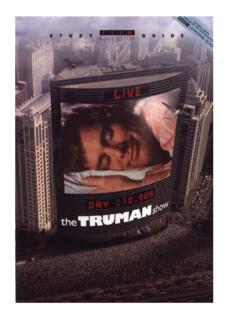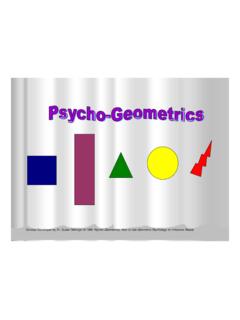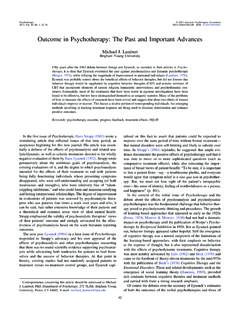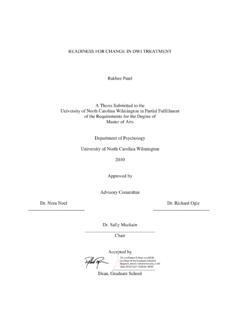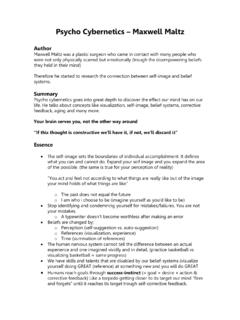Transcription of PSYCHO - Film Education
1 PSYCHOSTUDY GUI TEACHERS NOTESThis study guide is aimed at students of GCSE Media Studies, A Level Media Studies, A LevelFilm Studies and GNVQ Media: Communication and Production (Intermediate andAdvanced).The guide looks at Alfred Hitchcock as a director and producer; narrative structure;characterisation; the use of music, motifs and irony; promotion of the film and problems : Certificate 15. Running Time 109 FORPSYCHOP sycho 1960 (Paramount)Producer: Alfred HitchcockDirector: Alfred HitchcockScreenplay: Joseph StefanoDirector of Photography: John L. RussellEditor: George TomasiniMusic: Bernard HerrmannArt Directors: Joseph HurleyRobert ClatworthyCast: Anthony PerkinsJanet LeighVera MilesJohn GavinMartin BalsamJohn MeintireOscar Nominations 1960: Best DirectorBest Supporting Actress (Janet Leigh)Best B/W CinematographyBest B/W Art Film Education .
2 Film Education is not responsible for the content of external BYDEREKMALCOLMMany filmmakers would say that there s no such thing as a movie capable of shaking theworld. But some still attempt to make them. Those who succeed are rare, and the strangething is that even the lucky ones don t appear to know they are doing it at the time. In fact, itsometimes takes years to realise what really is a great film or what may have looked wonderfulat the time but was just a momentary of the films on this particular list didn t so much shake the world as becomememorable because, when you look back on them, they seem so much better than we mayhave thought at the time. But memories are short and the opportunity to see the full floweringof cinema history is denied to all but a few. So the list looks a little unbalanced to me, whohas been luckier than most in looking further into the past and at world cinema rather thanjust we get here are films that were certainly important in their time, and still look goodtoday- movies that have remained in people s affections ever since they first saw them.
3 If therearen t really enough from the first two-thirds of cinema history, no matter. Its good at least toknow that some of the greatest directors in the world are represented and that their artistry,often the equivalent of any great playwright, painter, author or composer of the twentiethcentury, continues to he appreciated. Most of these films will live longer than we Welles was a master, so was the far more prolific Alfred Hitchcock, once thought of as merelya great but shallow entertainer. He was a subtle craftsman who elevated his low cunning intohigh art. PSYCHO may not have been his best or most sophisticated film but it has become oneof his most popular and successful. It has been described as the mother of the modern horrormovie. But, if so, she s spawned some odd children. What isn t often recognised is that Psychowas a distinct change of pace by Hitchcock, who reverted to black and white from colour andhad to put up with the kind of constraints that were imposed upon him by his TV series, AlfredHitchcock Presents.
4 The result really did shake the world, with its black sense of humour andits textbook example of how to manipulate an audience into fear and loathing. But the filmwas also a critique of the cruelty of life it was actually based on the history of thecannibalistic Wisconsin killer Ed Gein, as was the much later Texas Chainsaw Massacre. Butagain, this is a collaborative effort. Even the famous shower scene, put together by Saul Bass,would have been much less effective without Bernard Herrmann's nerve-wracking was a dab hand at perversity, but he had some pretty able Film Education . Film Education is not responsible for the content of external Hitchcock s PSYCHO was first screened in New York on 16 June 1960. It was animmediate box-office success. From the start, expectant filmgoers began queuing in Broadwayat setting a pattern for audiences worldwide.
5 By the end of its first year, PSYCHO hadearned $15 million over fifteen times as much as it cost to was a watershed in many ways. As well as making Alfred Hitchcock amultimillionaire, it was to win huge critical acclaim and enshrine him as a master generated two sequels itself and set down a formula for madman with knife films,shamelessly copying its film techniques. It also influenced the makers of many of the mostwell-known modern horror and suspense films, ranging from Halloween to Fatal s commercial success was due, in part, to a superbly orchestrated publicity andmarketing campaign that set new standards for audience manipulation. Hitchcock insistedpeople alter their cinema-going habits if they wished to see his film, and in doing so, hehelped create film-viewing conventions that we now take for is claimed that the film reflected, or contributed to, a growing permissiveness in society:its violence, sexual content and even the flushing of a toilet on screen, all breaking newground for mainstream Hollywood film.
6 Its themes struck at many cherished American values;mother love, in particular, would never be quite the same again. Following its release, Psychowas even blamed in court for being the cause of a number of horrible murders, stimulating adebate about the links between screen violence and anti-social behaviour that continuesunabated to this Film Education . Film Education is not responsible for the content of external is impossible to recreate the experience of the audiences who first flocked to see PSYCHO ,unsure of what they were about to witness. Even if you have not already seen PSYCHO , you maywell have heard a great deal about it even its ending but before you watch it in class, tryto describe what expectations you have of the ideas does the title ' PSYCHO ' bring to mind? What emotions does the title create in you excitement, dread, curiosity?
7 Try to explain your at the poster for the film on the cover of this guide. What do you notice about thelettering in the title graphics? What effect does the word ' PSYCHO ' have on you? Does it add toyour expectations of the film? What does it suggest about the mind of or behaviour we canexpect from the person it refers to? PSYCHO was released in 1960. Do you expect that it will be old fashioned? In what ways?KHITCHCOCK- DIRECTORAND PRODUCERKWhen you hear the name Steven Spielberg, what kind of filmwould you expect to see? If you can answer this question, you willunderstand the similar power that Alfred Hitchcock had over thecinema-going public in 1959, when he decided to make PSYCHO , his47th s directing career started in 1922. By 1959 he was oneof Hollywood s best-known personalities. His films often containeda short personal appearance by him as an extra, sometimes carryingor wearing something that drew attention to his size or made himlook silly.
8 In PSYCHO he is the man in the Stetson standing on thestreet, who glances at Marion Crane as she returns late from herlong lunch break with Sam. His television programme, AlfredHitchcock Presents, was amongst the top ten shows then being screened and his humorous,but rather twisted introductions to these Sunday night mystery dramas, further increased hisreputation for the unusual and the book by Robert Bloch based on the real-ife killings of psychopath Ed Gein in Plainfield,Wisconsin, had already been rejected by Paramount Studios as impossible to film , whenHitchcock paid $9,000 for the film rights. Paramount were horrified that Hitchcock shouldconsider PSYCHO suitable material, and did everything they could to put him off; even claimingthat there was no Paramount studio space available for him to was determined to film PSYCHO and came up with a financial formula that evenParamount could not refuse.
9 He agreed to pay for the film himself and give up his usual$250,000 director s fee. He even arranged to make the film using facilities at Paramount s rivalstudio, Universal International. In exchange, Paramount agreed to promote and distribute thefilm and give Hitchcock sixty per cent ownership of the final Film Education . Film Education is not responsible for the content of external FILMING OF PSYCHOKIn his role as both director and producer, Hitchcock was in the privileged position of havinga great deal of involvement in the actual planning and filming of PSYCHO . His originality in thisarea contributed greatly to the unique nature of the film. TaskThe following section of the PSYCHO script describes Lila's approach to the Bates' house fromthe motel, near the end of the film. The words in capital letters are the camera instructionsthat Hitchcock added.
10 Compare it to the actual sequence in the film. How similar is thescreenplay to the finished product? What differences can you see? What does this tell youabout Hitchcock s pre-planning before the filming began? (A subjective shot reproduces theviewpoint of the character; it is as if we are looking through their eyes). What does the musicadd to the scene? How different wouldthis scene have been ifHitchcock had put thecamera in one placeand filmed Lila as shewalked up to the housefrom one position only?What would be lostfrom the sequence?Take another shortsequence from any-where in the film inwhich there is no sound( Marion packing toleave with the money). Create your own bitof PSYCHO screenplay bydescribing the thingsyou see and adding thecamera Film Education . Film Education is not responsible for the content of external REAR OF MOTEL - [SUBJECTIVECLOSE-UP] - DAYB ehind the motel Lila hesitates.
